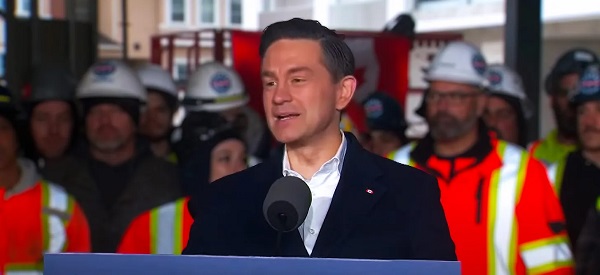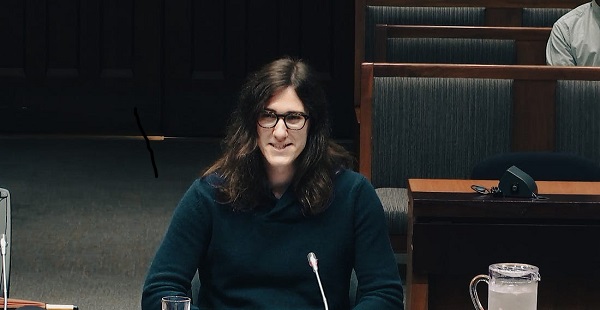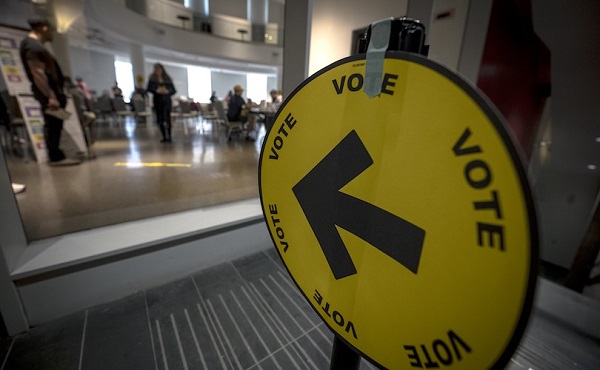2025 Federal Election
Real Homes vs. Modular Shoeboxes: The Housing Battle Between Poilievre and Carney


 Dan Knight
Dan Knight
Mark Carney’s housing plan is more state control and modular misery.
It’s not every day a Canadian politician offers a clear, structured plan to fix something in this country. But that’s what happened in Scarborough on April 21, when Conservative Leader Pierre Poilievre stepped to the mic and laid out his vision for tackling Canada’s worsening housing crisis—and, more broadly, for dismantling the economic scaffolding the Liberals have spent the last decade building.
Now, to be clear: this wasn’t a moment of messianic deliverance. It was a campaign speech. Poilievre is a politician. He’s trying to win. But the contrast he drew—between a country spiraling into economic stagnation under Trudeau-era policy and one potentially emerging from it—is the real story here. And for the first time in a long time, the Liberals should be worried. Because they’re being outflanked not with bluster, but with structure.
A Decade of Decay
Poilievre opened with what he called the “lost Liberal decade”—ten years of growing inflation, collapsing affordability, increased crime, and institutional arrogance. And he’s not wrong. The cost of living in Canada has exploded. Homeownership—once the cornerstone of middle-class life—has become a distant fantasy for an entire generation. Violent crime is up. Street disorder is normalized. The country is, in practical terms, unrecognizable from what it was even five years ago.
And while Justin Trudeau has technically exited stage left, his policies remain. His advisors remain. And his economic worldview remains—in the person of Mark Carney, the unelected banker now fronting the Liberal Party’s future.
Poilievre made a point of naming him directly: Mark Carney, Trudeau’s economic consigliere, now trying to take the wheel after years behind the curtain. And with him comes a Liberal platform that, incredibly, proposes **$130 billion in new spending—more than Trudeau’s own budget—**without any clarity on how to pay for it, beyond $28 billion in undefined “cuts.”
In Poilievre’s framing, this is not a reset. It’s a continuation. Same agenda. Same inflationary pressure. Same bureaucratic paralysis. And for a country already on the edge, that’s not a choice—it’s a warning.
A Hard Policy Pivot
So what did Poilievre propose?
First, he named a number: 2.3 million new homes built over five years. That alone sets him apart from most of the field, who are still dealing in abstractions and talking points. He detailed how to get there: axe the GST on new housing, penalize municipalities that block construction, unlock 15% of federal land for homebuilding, and—here’s where it gets controversial for polite Ottawa society—cap immigration so the number of newcomers doesn’t outpace the number of homes being built.
Let that sink in.
He said it plainly: you cannot invite more people into the country than you have homes to shelter them. It’s not xenophobic. It’s math. It’s called infrastructure planning, and for some reason, it’s been taboo in federal politics for years. But ask any Canadian renter stuck in a bidding war over a 600-square-foot shoebox if supply and demand matter. They’ll tell you the truth politicians won’t.
Now, some of this is ambitious—perhaps even too ambitious. The housing market is not a light switch. But at least it’s a plan built on reality. The math isn’t ideological. If demand grows faster than supply, prices rise. Period. It’s not controversial unless you live in Ottawa.
Now, some of this is ambitious—perhaps even too ambitious. The housing market is not a light switch. But at least it’s a plan built on reality. The math isn’t ideological. If demand grows faster than supply, prices rise. Period. It’s not controversial unless you live in Ottawa.
Beyond housing, Poilievre’s broader agenda was clear: unleash the resource economy.
He pledged to repeal Bill C-69, kill the emissions cap, approve projects like LNG Canada and LNG Quebec in six months, and end the tanker ban off B.C.’s coast. This, he said, would unlock $500 billion in economic growth over five years. That number might be aggressive, but again—it’s grounded in something Canada used to be good at: developing natural resources.
Carney’s plan, in contrast, leans into centralization, green transition subsidies, and modular housing units dropped on federal land—bureaucracy dressed as boldness.
Law and Order, and the Limits of Civility
Poilievre also spoke plainly about crime. He promised to “lock up criminals and secure the border.” Predictably, the media has called this coded language or dog-whistling. But Canadians living in cities like Toronto or Vancouver don’t need code. They need safety. You can debate tone all you want—but no one debates the crime stats.
On spending, Poilievre said he’d eliminate $10 billion in consultant costs, kill the gun buyback scheme, cut Trudeau’s failed drug programs, and cap government expansion. He promised no cuts to transfers for health or seniors, and pointedly noted that Carney’s vague savings plan relies on the same recycled Trudeau logic: say one thing, do another.
And then there was unity—an issue every federal leader pays lip service to, but few address seriously.
Poilievre’s angle was different. He said national unity isn’t built with slogans—it’s built with shared prosperity. Let Alberta build. Let Quebec profit. Let provinces manage their resources without Ottawa’s suffocating oversight. In a country this large, that’s not radical—it’s overdue.
The Liberal Modular 500k Housing Vision
And then there’s Mark Carney’s housing plan—because of course, the guy who spent the last decade cashing checks in London and New York now thinks he’s going to fix Canada’s housing crisis… with modular homes.
That’s right. Not by fixing the zoning nightmare, or the red tape, or the endless delays that make it impossible to build anything in this country. No—his solution is to give you a government-issued, prefabricated box.
He’s calling it “Build Canada Homes.” A brand new federal agency. Another one. This one will mass-order homes like they’re flat-packed sofas from IKEA, ship them out across the country, and drop them on public land.
This is what happens when you let central bankers do social planning.
Carney’s pitch? Modular homes are faster, cheaper, more climate-friendly. Sure, maybe they are. But that’s not the problem. The reason homes aren’t being built in Canada isn’t because we forgot how to hold a hammer. It’s because the federal government—and Carney’s Liberal friends—buried the housing industry in so much red tape it might as well be a fossil.
We’ve been building houses for a century. We know how to do it. We don’t need new materials. We need to get the bureaucrats out of the way.
But Carney doesn’t see it that way. He wants a centralized agency to handle housing. He wants to finance prefab boxes with public money, dress it all up in climate buzzwords, and call it innovation. You won’t get a home. You’ll get a “low-carbon living module” made from ethically sourced pine.
That’s not a housing plan. That’s a spreadsheet fantasy cooked up by a guy who’s never swung a hammer in his life.
And let’s be honest: he’s not doing this for you.
He’s doing it for himself. To parachute into power. To play savior after spending years abroad. After GFANZ collapsed under his leadership. After every major bank walked away from his climate alliance. And now he’s here, failing upward into the Liberal Party.
So yes, his plan is modular.
Modular, managed, and completely disconnected from reality.
Final Thoughts – This Election Is About the Country We Want Back
Let’s stop pretending this is a normal election. It’s not. This isn’t about policy tweaks or campaign slogans. It’s a war for the soul of the country.
Because what we’re watching is a choice between two paths:
One, where we keep doing what we’ve done for the last ten years—spend, spend, spend, funnel more of your money into the Ottawa swamp, prop up the same broken institutions, and pretend things will magically get better.
Or two—we take it back. We vote Canada First, and we start building a country that works for the people who live here—not for bureaucrats, bankers, or international conference junkies.
And then there’s Mark Carney. The man Liberals are trying to sell as a leader. But he hasn’t spent the last ten years living the consequences of these policies. He wasn’t here while housing collapsed. He wasn’t here while crime went up, groceries doubled, and our energy sector got strangled. He was in New York. London. Davos.
He made his money outside this country, in boardrooms, hedge funds, and private equity—and now he parachutes in, thinking he can land a cheap political win?
No.
That’s not how this is supposed to work.
We don’t want leaders who failed upwards through global institutions. We want leaders who earned their place—by showing up, standing up, and actually fighting for the people who built this country.
Carney’s GFANZ alliance failed. His global climate finance cartel fell apart. And now he’s bringing the same failed philosophy here—central planning, top-down control, and another $130 billion in borrowed promises.
This election isn’t about left versus right.
It’s about Canada versus the machine.
And the machine is bloated, unaccountable, and completely out of touch.
So let me say it as clearly as I can:
If you want prosperity, you don’t fund the swamp.
You drain it.
You fire it.
You replace it with something real.
And you vote for a country that puts its people first—not last.
That’s the choice.
Vote Canada First.
2025 Federal Election
Protestor Behind ‘Longest Ballot’ Chaos targeting Poilievre pontificates to Commons Committee

Lawmakers confront organizer Tomas Szuchewycz for flooding ridings with placeholder candidates, targeting Pierre Poilievre’s seat, and wasting public resources.
Szuchewycz’s most notorious move came in Carleton — the riding of Conservative Leader Pierre Poilievre, where the ballot swelled to 91 names, stretching nearly a metre and forcing Elections Canada to redesign how it printed and handled the vote. The LBC framed the stunt as a protest against Canada’s first-past-the-post electoral system. But to most voters, it looked nothing like a principled reform campaign. What they saw was an effort aimed squarely at Poilievre, meant to bury his name among a wall of nobodies and turn the vote into a farce.
Elections Canada had to scramble to manage the chaos: printing extra‑long ballots, re‑training workers, and creating a last‑minute write‑in workaround in Battle River–Crowfoot to keep ballots usable. Seniors and disabled voters complained about the physical size and complexity of the ballot; poll workers faced new logistical headaches; public money was wasted.
At Tuesday’s hearing, Szuchewycz showed no contrition and offered no practical alternative to the system he had tried to upend. Instead, he accused MPs of having a “conflict of interest” in writing election law and demanded that power be handed to an undefined “permanent, non‑partisan body” — without explaining who would select it, how it would operate, or how it would be accountable to Canadians.
The LBC, whose actions led to metre-long ballots in ridings like Carleton (91 candidates) and Battle River–Crowfoot (86), claims to oppose Canada’s first-past-the-post system. But when asked how his proposed independent reform body would be formed, selected, or held accountable, Szuchewycz had no answers.
Conservative MP Michael Cooper led the charge, accusing Szuchewycz of overseeing a signature-harvesting scheme that involved electors signing blank nomination forms—potentially in violation of the Canada Elections Act. He tabled a January 2024 tweet and an August 2024 YouTube video showing organizers gathering signatures under the claim that candidate names would be “filled in later.”
Szuchewycz denied the accusation, claiming nomination papers had either candidate names or the phrase “all candidates” filled in. But when he tried to discredit Cooper’s evidence by calling it “AI-generated,” the committee chair issued a warning for casting doubt on the authenticity of a Member’s documents without basis. The comment was withdrawn under pressure.
Still, Cooper was unsatisfied, warning Szuchewycz that misleading Parliament could amount to contempt.
Other witnesses—experts and former elected officials—were equally critical of the LBC’s tactics. Dr. Lori Turnbull, a professor at Dalhousie University, called the stunt “undesirable” and a “waste of resources,” though she praised Elections Canada for adapting quickly by allowing a write-in workaround in Battle River–Crowfoot to avoid printing a literal wall of names.
Professor Peter Loewen of Cornell University added that the LBC’s ballot-stuffing “violates the spirit” of competitive democracy and burdens front-line elections staff with unnecessary logistical chaos. He warned that a third-party group acting like a political party without oversight was a loophole that needed closing.
Meanwhile, former Liberal MP Louis-Philippe Sauvé described the real-world toll of the stunt: longer lineups, stressed poll workers, and accessibility hurdles for elderly and visually impaired voters.
In stark contrast to these grounded critiques, Szuchewycz’s testimony revolved around vague accusations of “conflict of interest” by MPs and a call to remove Parliament from electoral reform altogether. No constitutional roadmap. No governance model. No practical enforcement mechanism.
At the end of the day, what Tomas Szuchewycz has done isn’t just a stunt, it’s an insult. He claims Canadians “know what he’s protesting,” but let’s be honest: most voters had no clue this was about electoral reform. What they saw was a campaign to flood ballots with nonsense names in key ridings, especially against the Leader of the Opposition, and create chaos for chaos’s sake.
The takeaway wasn’t a conversation about democracy. It was a spectacle, and one that mocked the very voters he pretends to represent. Lets be clear, This wasn’t activism, it was ego masquerading as principle. And it reeked of entitlement.
Tomas Szuchewycz is the embodiment of unchecked privilege: a man who hijacked our electoral process, wasted taxpayer dollars, and offered nothing in return but smug contempt for the very democracy that gave him the space to pull his stunt.
He claims Canadians understood his message. They didn’t. Most people saw a confusing mess, an attack on the Opposition Leader, and a joke made at the expense of voters, poll workers, and the electoral system itself.
So yes — reform is coming. And it can’t come soon enough.
Parliament must not just close the loopholes it should make sure that when someone deliberately sabotages the integrity of an election, they are held accountable, including being forced to repay the public for the cost of their chaos.
Because in a democracy, you have the right to protest.
But not the right to turn an election into a farce on the public’s dime.
Subscribe to The Opposition with Dan Knight
Invite your friends and earn rewards
2025 Federal Election
Post election report indicates Canadian elections are becoming harder to secure

Chief Electoral Officer Stéphane Perrault highlights strong participation and secure voting, but admits minority politics, rising costs, and administrative pressures are testing the system’s limits.
Monday in Ottawa, Stéphane Perrault, Canada’s Chief Electoral Officer, delivered a long press conference on April’s federal election. It was supposed to be a victory lap, record turnout, record early voting, a secure process. But if you listened closely, you heard something else: an admission that Canada’s election machinery is faltering, stretched thin by a system politicians refuse to fix.
Perrault touted the highest turnout in 30 years, 69 percent of eligible voters, nearly 20 million Canadians. Almost half of those ballots were cast before election day, a dramatic shift in how citizens take part in democracy.
“Twenty years ago, less than 7% voted early. This year, nearly half did,” Perrault told reporters. “Our system may have reached its limit.”
That’s the core problem. The system was built for one decisive day, not weeks of advance voting spread across campuses, long-term care homes, mail-in ballots, and local Elections Canada offices. It’s no longer a single event; it’s an extended process that stretches the capacity of staff, polling locations, and administration.
Perrault admitted bluntly that the 36-day writ period, the time between when an election is called and when the vote happens, may no longer be workable. “If we don’t have a fixed date election, the current time frame does not allow for the kind of service preparations that is required,” he said.
And this is where politics collides with logistics. Canada is once again under a minority government, which means an election can be triggered at almost any moment. A non-confidence vote in the House of Commons, where opposition parties withdraw support from the government, can bring down Parliament in an instant. That’s not a flaw in the system; it’s how parliamentary democracy works. But it leaves Elections Canada on permanent standby, forced to prepare for a snap election without knowing when the writ will drop.
The result? Sixty percent of voter information cards were mailed late this year because Elections Canada couldn’t finalize leases for polling stations on time. Imagine that, more than half the country got their voting information delayed because the system is clogged. And that’s when everything is supposedly working.
The April election cost an estimated $570 million, almost identical to 2021 in today’s dollars. But here’s the kicker: Elections Canada also spent $203 million just to stay ready during three years of minority Parliament. That’s not democracy on the cheap. That’s bureaucracy on retainer.
Perrault admitted as much: “We had a much longer readiness period. That’s the reality of minority governments.”
No Foreign Interference… But Plenty of ‘Misinformation’
Canada’s top election official wanted to make something perfectly clear: “There were no acts of foreign interference targeting the administration of the electoral process.” That’s the line. And it’s a good one… reassuring, simple, the kind of phrase meant to make headlines and calm nerves.
But listen closely to the wording. He didn’t say there was no interference at all. He said none of it targeted the administration of the vote. Which raises the obvious question: what interference did occur, and who was behind it?
Perrault admitted there was “more volume than ever” of misinformation circulating during the 2025 election. He listed the greatest hits: rumors that Elections Canada gives voters pencils so ballots can be erased, or claims that non-citizens were voting. These are hardly new — they’ve appeared in the U.S. and in Europe too. The difference, he said, is scale. In 2025, Canadians saw those narratives across more channels, more platforms, more communities than ever before.
This is where things get interesting. Because the way Perrault framed it wasn’t that a rogue actor or a foreign intelligence service was pushing disinformation. He was blunt: this was a domestic problem as much as anything else. In his words, “whether foreign or not,” manipulation of information poses the “single biggest risk to our democracy.”
Perrault insists the real danger isn’t foreign hackers or ballot-stuffing but Canadians themselves, ordinary people raising questions online. “Information manipulation, whether foreign or not, poses the single biggest risk to our democracy,” he said.
Well, maybe he should look in the mirror. If Canadians are skeptical of the system, maybe it’s because the people running it haven’t done enough to earn their trust. It took years for Ottawa to even acknowledge the obvious , that foreign actors were meddling in our politics long before this election. Endless commissions and closed-door reports later, we’re told to stop asking questions and accept that everything is secure.
Meanwhile, what gets fast-tracked? Not a comprehensive fix to protect our democracy, but a criminal investigation into a journalist. Keean Bexte, co-founder of JUNO News, is facing prosecution under Section 91(1) of the Canada Elections Act for his reporting on allegations against Liberal candidate Thomas Keeper. The maximum penalty? A $50,000 fine and up to five years in prison. His reporting, incidentally, was sourced, corroborated, and so credible that the Liberal Party quietly dropped Keeper from its candidate list.
If people doubt the system, it isn’t because they’re gullible or “misinformed.” It’s because the government has treated transparency as an afterthought and accountability as an inconvenience. And Perrault knows it. Canadians aren’t children to be scolded for asking questions, they’re citizens who expect straight answers.
But instead of fixing the cracks in the system, Ottawa points the finger at the public. Instead of rebuilding trust, they prosecute journalists.
You don’t restore faith in democracy by threatening reporters with five years in prison. You do it by showing, quickly and openly, that elections are beyond reproach. Until then, spare us the lectures about “misinformation.” Canadians can see exactly where the problem lies, and it isn’t with them.
The Takeaway
Of course, they’re patting themselves on the back. Record turnout, no servers hacked, the trains ran mostly on time. Fine. But what they don’t want to admit is that the system barely held together. It was propped up by 230,000 temporary workers, leases signed at the last minute, and hundreds of millions spent just to keep the lights on. That’s not stability. That’s triage.
And then there’s the lecturing tone. Perrault tells us the real threat isn’t incompetence in Ottawa, it’s you, Canadians “sharing misinformation.” Excuse me? Canadians asking questions about their elections aren’t a threat to democracy, they are democracy. If the government can’t handle people poking holes in its story, maybe the problem isn’t the questions, maybe it’s the answers.
So yes, on paper, the 2025 election looked like a triumph. But listen closely and you hear the sound of a system cracking under pressure, led by officials more interested in controlling the narrative than earning your trust. And when the people running your elections think the real danger is the voters themselves? That’s when you know the elastic isn’t just stretched. It’s about to snap.
-

 COVID-191 day ago
COVID-191 day agoUniversity of Colorado will pay $10 million to staff, students for trying to force them to take COVID shots
-

 Bruce Dowbiggin1 day ago
Bruce Dowbiggin1 day agoIntegration Or Indignation: Whose Strategy Worked Best Against Trump?
-

 Focal Points2 days ago
Focal Points2 days agoCommon Vaccines Linked to 38-50% Increased Risk of Dementia and Alzheimer’s
-

 espionage1 day ago
espionage1 day agoWestern Campuses Help Build China’s Digital Dragnet With U.S. Tax Funds, Study Warns
-

 Opinion2 days ago
Opinion2 days agoThe day the ‘King of rock ‘n’ roll saved the Arizona memorial
-

 Bruce Dowbiggin1 day ago
Bruce Dowbiggin1 day agoWayne Gretzky’s Terrible, Awful Week.. And Soccer/ Football.
-

 Agriculture1 day ago
Agriculture1 day agoCanada’s air quality among the best in the world
-

 Health1 day ago
Health1 day agoCDC Vaccine Panel Votes to End Universal Hep B Vaccine for Newborns










